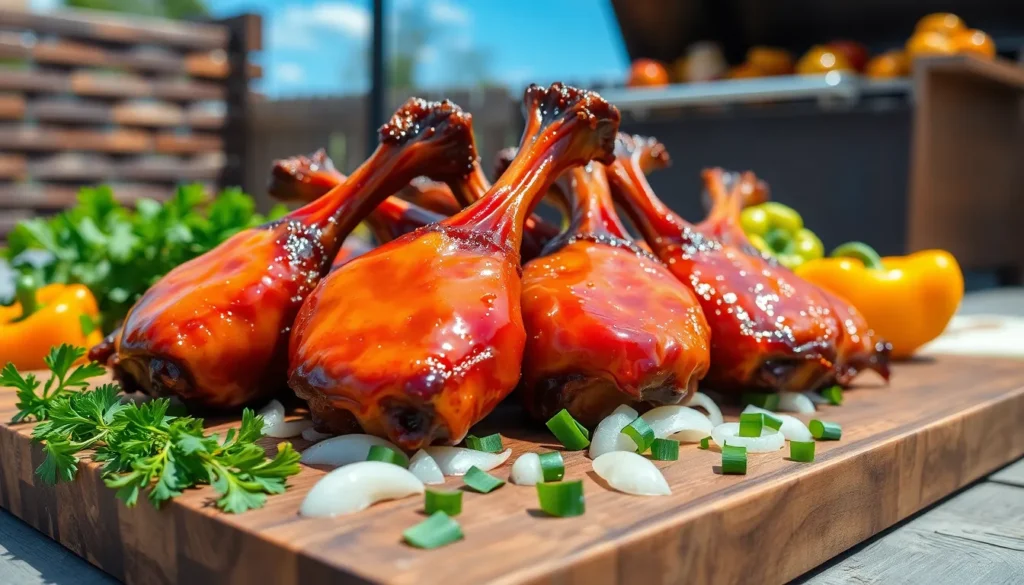We’ve discovered one of the most underrated cuts of turkey that’ll transform your barbecue game forever. Smoked turkey tails pack incredible flavor and deliver that perfect combination of crispy skin and succulent meat that makes your mouth water just thinking about it.
These often-overlooked gems are packed with rich, dark meat and natural fats that create an incredibly juicy result when smoked low and slow. Turkey tails have been a beloved delicacy in Southern cuisine for generations, and once you try our foolproof smoking method, you’ll understand why pitmasters swear by them.
What makes turkey tails so special is their natural marbling and bone-in structure that keeps the meat incredibly moist throughout the smoking process. We’ll show you exactly how to season, prep, and smoke these flavorful cuts to perfection, creating a dish that’s sure to become your new favorite barbecue obsession.
What Are Turkey Tails
Turkey tails represent one of the most flavorful yet overlooked parts of the bird. These triangular cuts come from the posterior end of the turkey and contain the tail vertebrae along with surrounding dark meat and skin. We often find that many home cooks discard this section without realizing its incredible potential for smoking and grilling.
The anatomy of turkey tails includes dense layers of fat and connective tissue that break down beautifully during low and slow cooking. This natural marbling creates exceptionally juicy meat with rich flavor that rivals the best dark meat portions. Each tail typically weighs between 8 to 12 ounces depending on the size of the bird.
Southern pitmasters have long recognized turkey tails as a delicacy worth celebrating. The cut contains higher fat content than breast meat which makes it nearly impossible to overcook when smoking. We appreciate how the natural oils baste the meat throughout the cooking process creating that coveted crispy skin exterior.
Turkey tails differ significantly from chicken or duck tails in both size and meat distribution. The turkey version offers more substantial meat portions while maintaining the rich fatty characteristics that make tails so desirable. Most butchers can source turkey tails upon request though they may require advance notice.
Fresh turkey tails display pinkish red meat with creamy white fat streaks and smooth unblemished skin. We recommend selecting tails that feel firm to the touch without any off odors. Frozen options work equally well provided they thaw completely before seasoning and preparation begins.
Equipment Needed for Smoking Turkey Tails

Smoking turkey tails to perfection requires exact equipment that maintains consistent low temperatures and provides proper heat control. We recommend using a smoker or grill with a lid capable of maintaining temperatures between 250-275°F for optimal results.
Essential Smoking Equipment
The foundation of successful turkey tail smoking starts with your heat source. Charcoal, wood, or gas can all create the indirect heat necessary for this low and slow cooking method. Your smoker or grill must accommodate indirect cooking to prevent the fatty turkey tails from flaring up over direct flames.
Temperature monitoring becomes critical when smoking turkey tails for extended periods. We always use a temperature probe or reliable meat thermometer to track both the cooking chamber temperature and the internal temperature of the meat. This dual monitoring ensures consistent cooking throughout the 2.5 hour smoking process.
Preparation and Handling Tools
Marinating equipment plays a vital role in developing flavor before smoking begins. Zip-top plastic bags work perfectly for containing the turkey tails with their vinegar-based marinade during the one hour refrigeration period. These bags allow for even distribution of the marinade while keeping your refrigerator clean.
Heat-resistant handling tools protect your hands and provide better control over the cooking process. Tongs or heat-resistant gloves enable safe manipulation of the turkey tails during seasoning, placement, and removal from the smoker. These tools become especially important when applying glazes to hot surfaces.
Glazing and Finishing Equipment
| Equipment Item | Purpose | Temperature Range |
|---|---|---|
| Small pot or saucepan | Making honey glaze | Direct heat over coals |
| Basting brush | Applying glaze evenly | Safe for 275°F+ |
| Aluminum foil | Optional oven finishing | Oven-safe |
A small pot or saucepan allows you to prepare the honey glaze directly over your heat source. This method keeps the glaze warm and easy to apply while maintaining the smoking temperature in your main cooking chamber.
Basting brushes designed for high heat applications ensure even glaze distribution across the turkey tail surfaces. We recommend silicone-bristled brushes that withstand the heat without melting or shedding bristles onto your food.
Optional finishing equipment includes aluminum foil or a roasting pan if you choose to complete cooking in an oven. Some pitmasters prefer moving the turkey tails indoors for the final glazing and tenderizing steps, especially when preparing smothered-style variations with gravy.
Ingredients
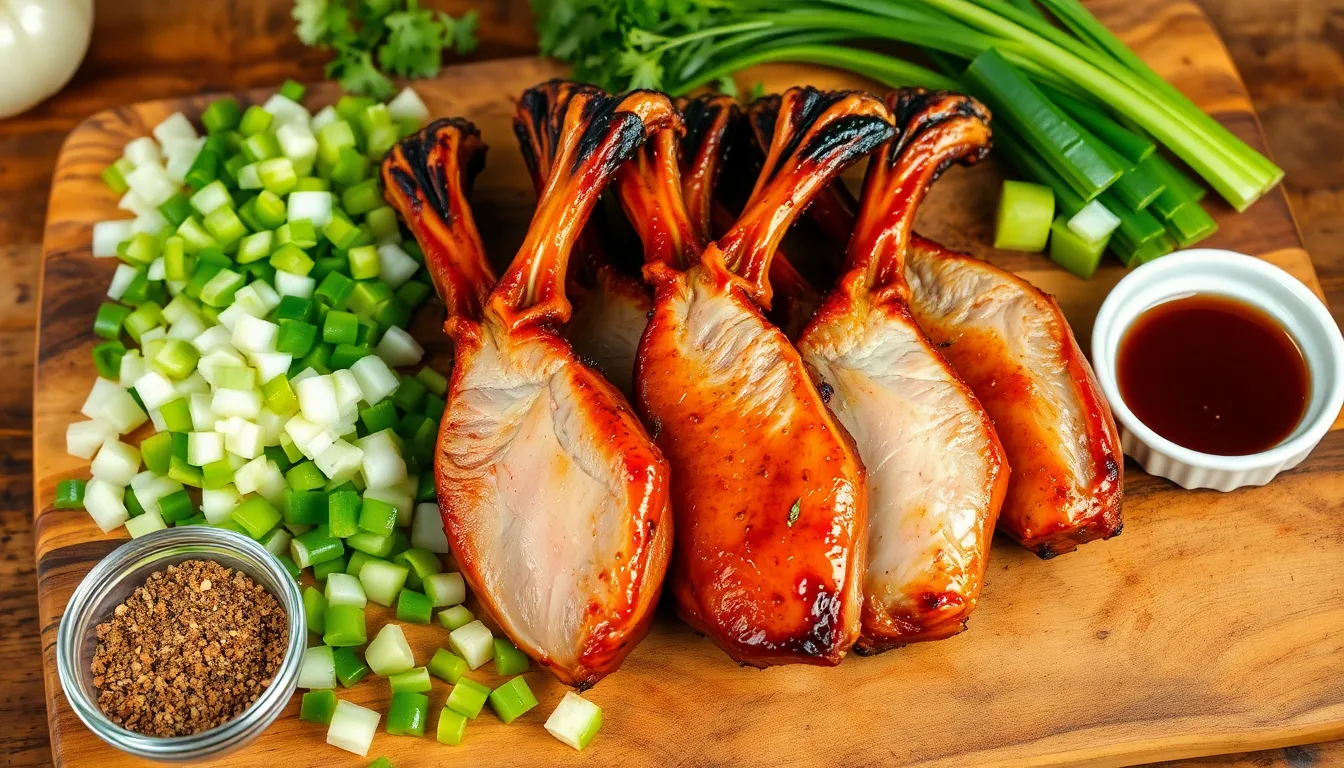
We’ve organized our ingredients into three categories to make preparation straightforward and ensure you have everything ready for this exceptional smoked turkey tails recipe. Each component plays a crucial role in creating the perfect balance of flavors and textures.
For the Turkey Tails
- 5 to 6 smoked turkey tails
- 1/2 cup chopped onions
- 1/2 cup chopped green bell peppers
- 1/3 cup chopped celery
- 4 cups chicken broth or water (for cooking)
For the Dry Rub
- 1-2 tablespoons turkey rub seasoning (can include salt, black pepper, garlic powder, onion powder, paprika, and cayenne)
- 1 teaspoon garlic powder
- 1 teaspoon onion powder
- Optional fresh herbs like thyme or parsley
For the Glaze (Optional)
- 1/2 cup honey
- 2 tablespoons soy sauce
- 2 tablespoons Dijon mustard
- 2 cloves garlic, minced
- Optional dash of hot sauce
Preparation

Proper preparation forms the foundation of exceptional smoked turkey tails. We’ll walk through each critical step to ensure your turkey tails are ready for the smoker.
Cleaning and Trimming the Turkey Tails
We begin by thoroughly inspecting each turkey tail for any remaining feathers or feather shafts that may have been missed during processing. Using a paper towel for better grip, we carefully remove any visible feathers or pin feathers from the skin surface.
Next, we rinse the turkey tails under cold running water to eliminate any residue or impurities that might affect the final flavor. The cold water helps firm up the meat while washing away any debris from the packaging or processing.
After rinsing, we pat each turkey tail completely dry using paper towels. This step is crucial because excess moisture prevents proper seasoning adhesion and can interfere with the smoking process.
Applying the Dry Rub
We generously season each turkey tail with approximately 1 tablespoon of turkey rub seasoning, ensuring even coverage across all surfaces. The seasoning should coat the skin, meat, and any exposed areas uniformly for consistent flavor development.
For enhanced flavor complexity, we mix the dry rub with garlic powder and other complementary spices before application. This creates a more robust flavor profile that penetrates deeper into the meat during the smoking process.
We massage the seasoning into the turkey tails using clean hands, working the spices into any crevices or natural grooves. This technique helps the flavors adhere better and creates a more even distribution throughout the meat.
Marinating Time
We place the seasoned turkey tails into a large zip-top bag or covered container for marinating. A marinade consisting of white vinegar, water, minced garlic, and 1 teaspoon of the turkey rub creates the perfect flavor-improving bath.
The turkey tails require approximately 1 hour of refrigerated marinating time to allow the flavors to penetrate the meat properly. This duration provides sufficient time for the acids in the vinegar to begin tenderizing the connective tissues while the spices infuse into the meat.
We seal the bag tightly after removing excess air to ensure maximum contact between the marinade and the turkey tails. This creates an environment where the flavors can work most effectively during the marinating process.
Smoker Setup
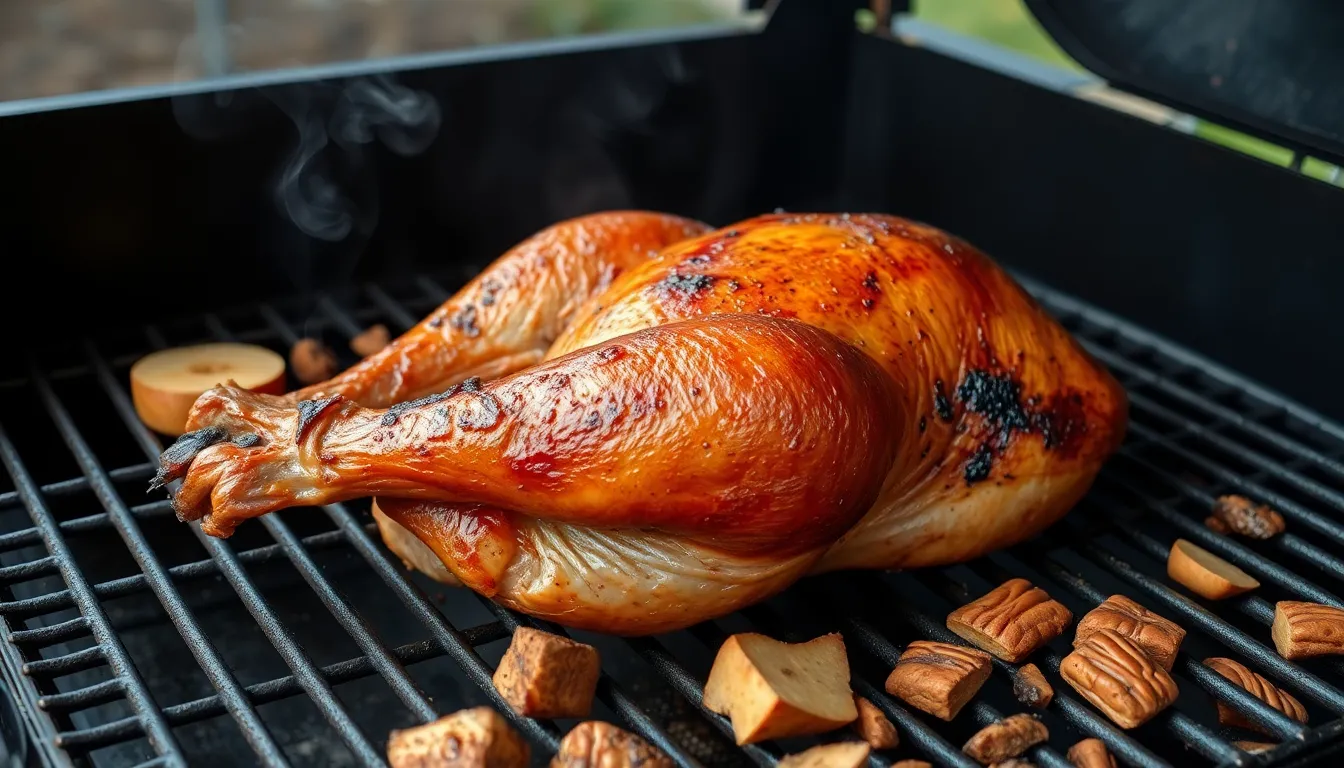
Setting up your smoker correctly forms the foundation for achieving perfectly smoked turkey tails with crispy skin and tender meat. We’ll walk you through the essential temperature and wood selection techniques that make all the difference.
Temperature Control
We recommend setting your smoker or grill to maintain an indirect heat zone between 250°F and 275°F for optimal results. This temperature range allows the fat to render slowly while creating that coveted crispy skin exterior that makes turkey tails so irresistible.
Position the turkey tails skin-side up on the smoker grates to prevent the skin from sticking and to promote even browning. We suggest using a reliable temperature probe to monitor both your cooking chamber and the internal meat temperature throughout the smoking process.
The indirect heat setup prevents dangerous flare-ups that could char the skin before the meat cooks through properly. We maintain this steady temperature for approximately 2.5 hours until the internal temperature reaches 205–210°F.
| Temperature Range | Cooking Time | Internal Target |
|---|---|---|
| 250°F – 275°F | 2.5 hours | 205°F – 210°F |
Wood Selection
We choose mild and slightly sweet wood varieties that complement rather than overpower the delicate turkey flavor. Apple cherry hickory and pecan woods work exceptionally well for smoking turkey tails because they impart subtle sweetness without dominating the meat.
Wood chunks perform better than chips for longer smoking sessions since they burn more slowly and provide consistent smoke output. We avoid aggressive woods like mesquite that can create bitter flavors and mask the natural richness of the turkey tails.
Adding wood to your smoker at the beginning of the cooking process ensures maximum smoke penetration into the meat. We recommend using 2-3 chunks of your chosen wood variety for the perfect balance of smoke flavor without overwhelming the dish.
Instructions
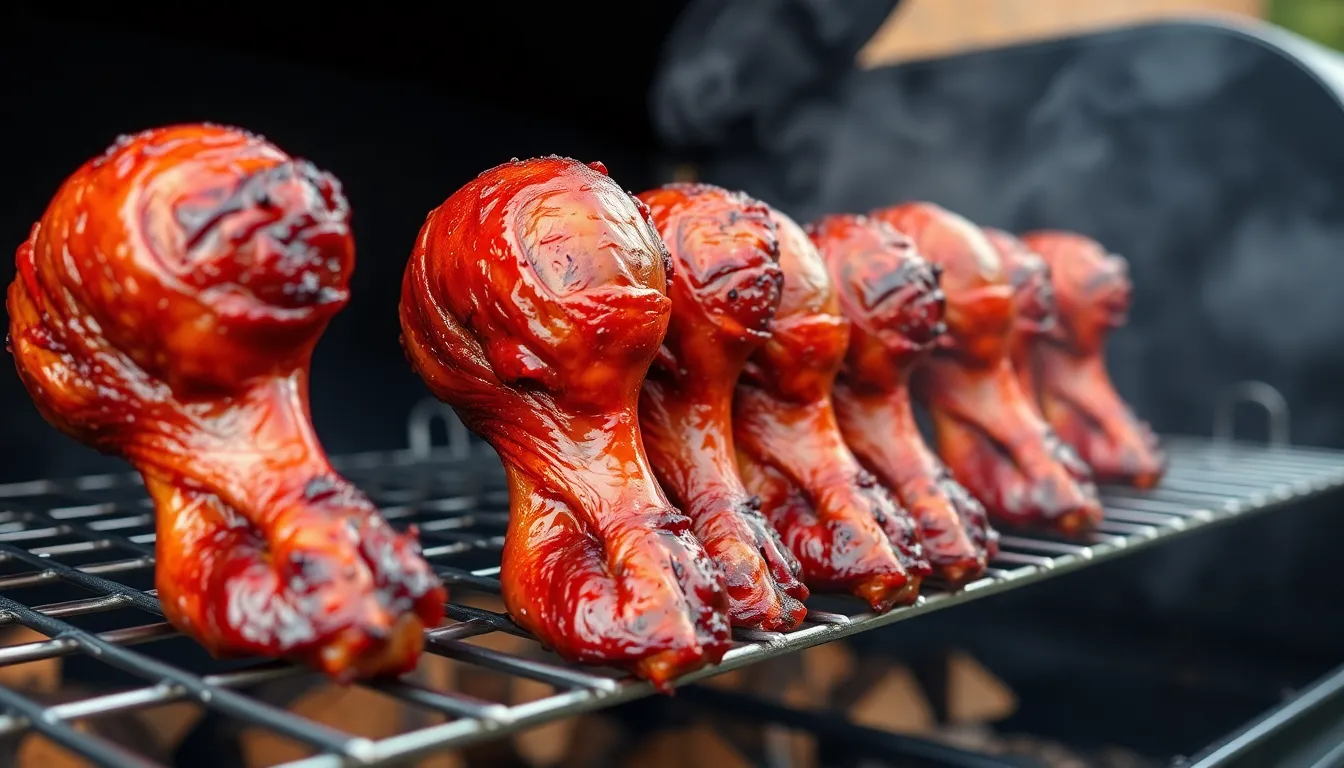
We’ll guide you through each critical step to achieve perfectly smoked turkey tails with tender meat and crispy skin. Our foolproof method ensures consistent results every time.
Preheating the Smoker
Begin by heating your smoker or grill to maintain a steady temperature between 250-275°F. Set up the cooking area for indirect heat by positioning coals or your heat source on one side while keeping the opposite side clear for the turkey tails. This configuration prevents direct flame exposure and allows for the slow cooking process essential for breaking down the connective tissues. Allow approximately 15-20 minutes for your smoker to reach and stabilize at the target temperature before adding your prepared turkey tails.
Smoking Process
Start by removing the marinated turkey tails from the refrigerator and patting them completely dry with paper towels. Apply your turkey rub seasoning thoroughly to all surfaces, ensuring even coverage for consistent flavor development. Place the seasoned turkey tails skin-side up on the smoker rack in the indirect heat zone to prevent sticking and promote proper browning.
Maintain the smoker temperature between 250-275°F throughout the cooking process. Smoke the turkey tails for approximately 2.5 hours until the skin develops a rich mahogany color and the meat becomes tender. Add your chosen wood chunks at the beginning of the smoking process to maximize smoke penetration and flavor development.
Monitoring Internal Temperature
Insert a reliable meat thermometer into the thickest portion of the turkey tail to track cooking progress accurately. Target an internal temperature range of 205°F to 210°F for optimal results. This temperature range ensures the fat has rendered properly and the connective tissues have broken down completely, creating the desired tender texture similar to pork belly.
Check the temperature periodically during the final hour of cooking to avoid overcooking. The high fat content in turkey tails makes them forgiving, but monitoring prevents any potential drying out of the meat.
Applying the Glaze
Prepare your glaze by combining honey, soy sauce, Dijon mustard, minced garlic, and a dash of hot sauce in a small pot. Simmer this mixture over the coals or heat source for 2-3 minutes until it reaches a smooth, coating consistency.
Brush the glaze generously over all surfaces of the turkey tails using a silicone basting brush during the final 15 minutes of cooking. Close the smoker lid immediately after glazing and allow the turkey tails to smoke for an additional 10 minutes. This final step sets the glaze and infuses the sweet and savory flavors into the crispy skin, creating the perfect finishing touch for your smoked turkey tails.
Cooking Times and Temperature Guide
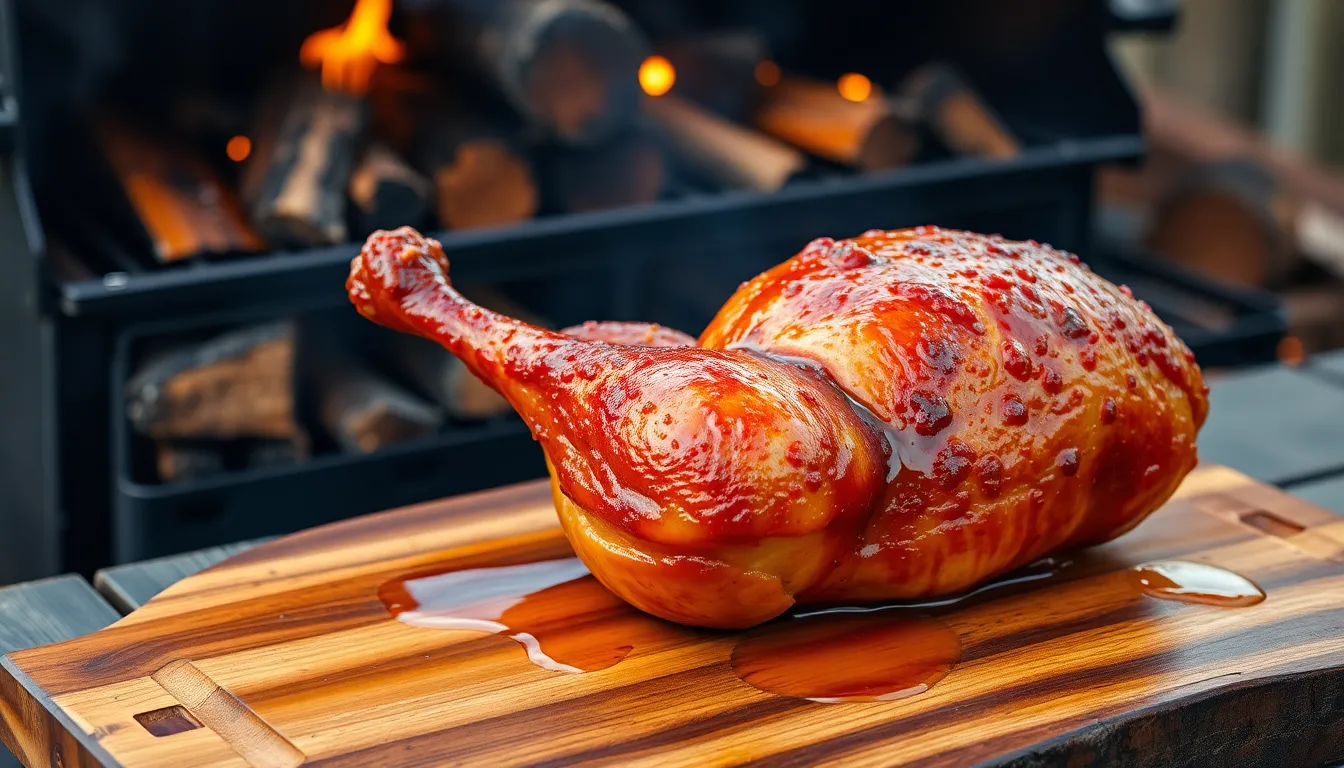
Mastering the temperature and timing for smoked turkey tails ensures consistently tender and flavorful results every time. We’ve compiled precise cooking data based on proven smoking techniques to help you achieve perfect doneness.
The optimal smoking temperature range sits between 250°F and 275°F for turkey tails. This low and slow approach allows the dense connective tissue and fat layers to break down gradually while developing that signature smoky flavor. We recommend maintaining 250°F for beginners as it provides more forgiving cooking conditions.
| Cooking Method | Temperature | Duration | Internal Target |
|---|---|---|---|
| Smoking Only | 250-275°F | 2.5 hours | 205-210°F |
| Smoking + Braising | 250-275°F + 350°F | 2.5 hours + 3.5 hours | 205-210°F |
| Stovetop Finish | 250-275°F + Simmer | 2.5 hours + 1 hour | Fork tender |
Turkey tails require an internal temperature of 205°F to 210°F for optimal tenderness. This higher temperature than typical poultry ensures the tough connective tissues completely break down into gelatin. We use a reliable meat thermometer inserted into the thickest part of the tail to monitor progress accurately.
The initial smoking phase takes approximately 2.5 hours at our target temperature range. During this time the skin develops a beautiful mahogany color while absorbing smoke flavor. We check for visual cues like crispy skin and rich color development alongside temperature readings.
Glazing occurs during the final 10 minutes of smoking for best results. We brush the honey glaze mixture onto the turkey tails then close the smoker lid to caramelize the sugars. This timing prevents burning while creating an attractive glossy finish.
Optional braising extends total cooking time to 6 hours but guarantees fall off the bone tenderness. We transfer the smoked turkey tails to a 350°F oven covered for 2.5 hours then uncover for the final hour. This method works perfectly when serving turkey tails over rice with gravy.
Stovetop simmering provides another finishing option requiring just 1 additional hour. We place the smoked turkey tails in simmering liquid until fork tender. This approach works well when incorporating the meat into dishes like collard greens or stews.
Rest time allows juices to redistribute throughout the meat after cooking. We recommend letting smoked turkey tails rest for 10 to 15 minutes before serving. This brief waiting period ensures maximum juiciness in every bite.
How to Tell When Turkey Tails Are Done
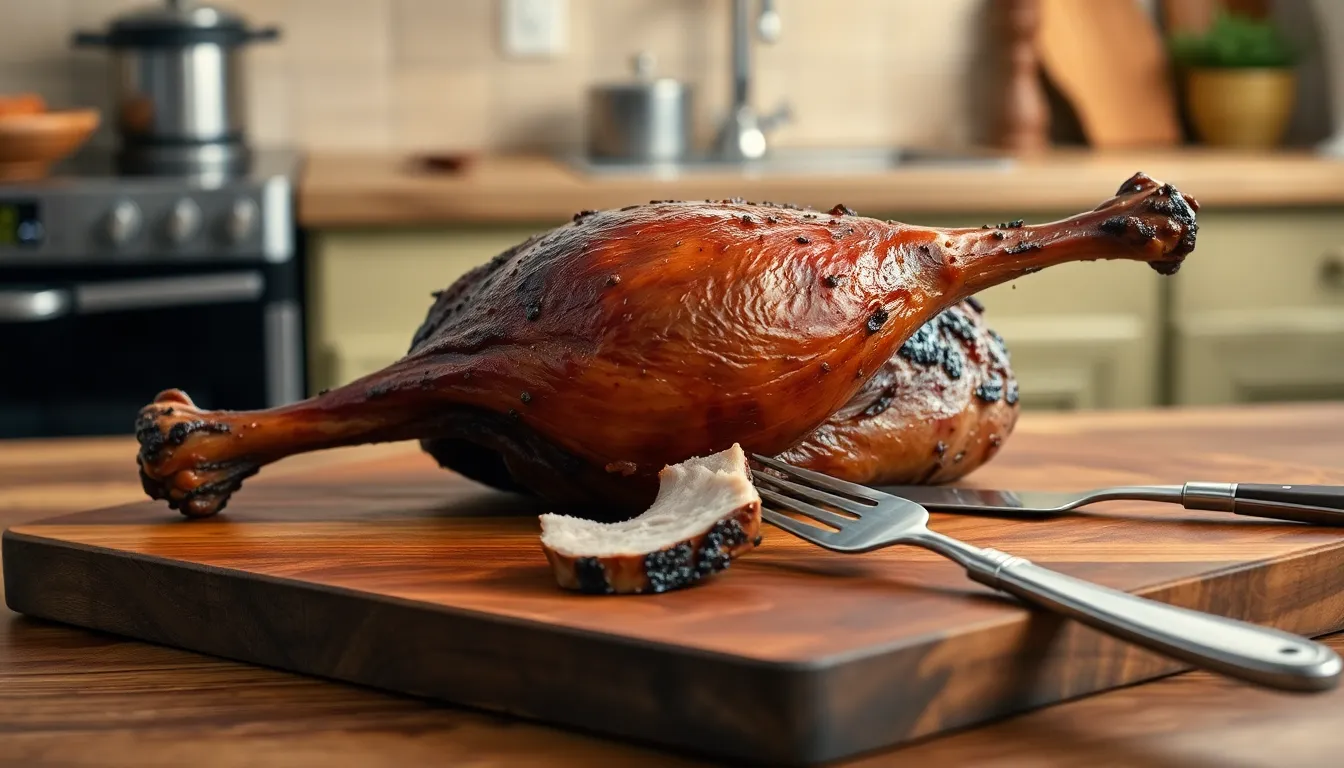
Determining when turkey tails have reached perfect doneness requires monitoring several key indicators that work together to ensure tender and flavorful results.
Internal Temperature Guidelines
The most reliable method for checking doneness involves using a meat thermometer to measure internal temperature. We recommend targeting an internal temperature between 205°F and 210°F for optimal tenderness. This temperature range ensures the connective tissues have fully broken down while maintaining the meat’s succulence.
| Temperature Range | Doneness Level | Texture Result |
|---|---|---|
| 180°F – 190°F | Undercooked | Tough, chewy |
| 205°F – 210°F | Perfect | Tender, juicy |
| Above 215°F | Overcooked | Dry, stringy |
Visual Indicators of Doneness
Skin color serves as an excellent visual cue for properly smoked turkey tails. The exterior should display a deep mahogany hue that indicates proper smoke absorption and cooking progress. This rich coloration develops gradually throughout the smoking process and signals that the skin has rendered properly.
The meat should easily separate from the bone when gently prodded with a fork or knife. Properly cooked turkey tails will show minimal resistance when the meat is tested for tenderness.
Texture and Tenderness Tests
Fork tenderness represents the gold standard for determining doneness in turkey tails. We test this by inserting a fork into the thickest part of the meat and twisting gently. The meat should yield easily without important resistance after 2 to 2.5 hours of cooking time.
The skin should feel slightly crisp to the touch while maintaining flexibility. Overcooking will result in brittle skin that cracks easily, while undercooking leaves the skin rubbery and unappetizing.
Timing Considerations
Turkey tails typically require 2 to 2.5 hours of cooking time when maintained at proper smoking temperatures. But, we always prioritize internal temperature and tenderness over strict timing guidelines since individual pieces may vary in size and density.
The meat should pull away slightly from the bone ends when fully cooked. This natural shrinkage occurs as the connective tissues break down and indicates that the turkey tails have reached optimal doneness for serving.
Resting and Serving
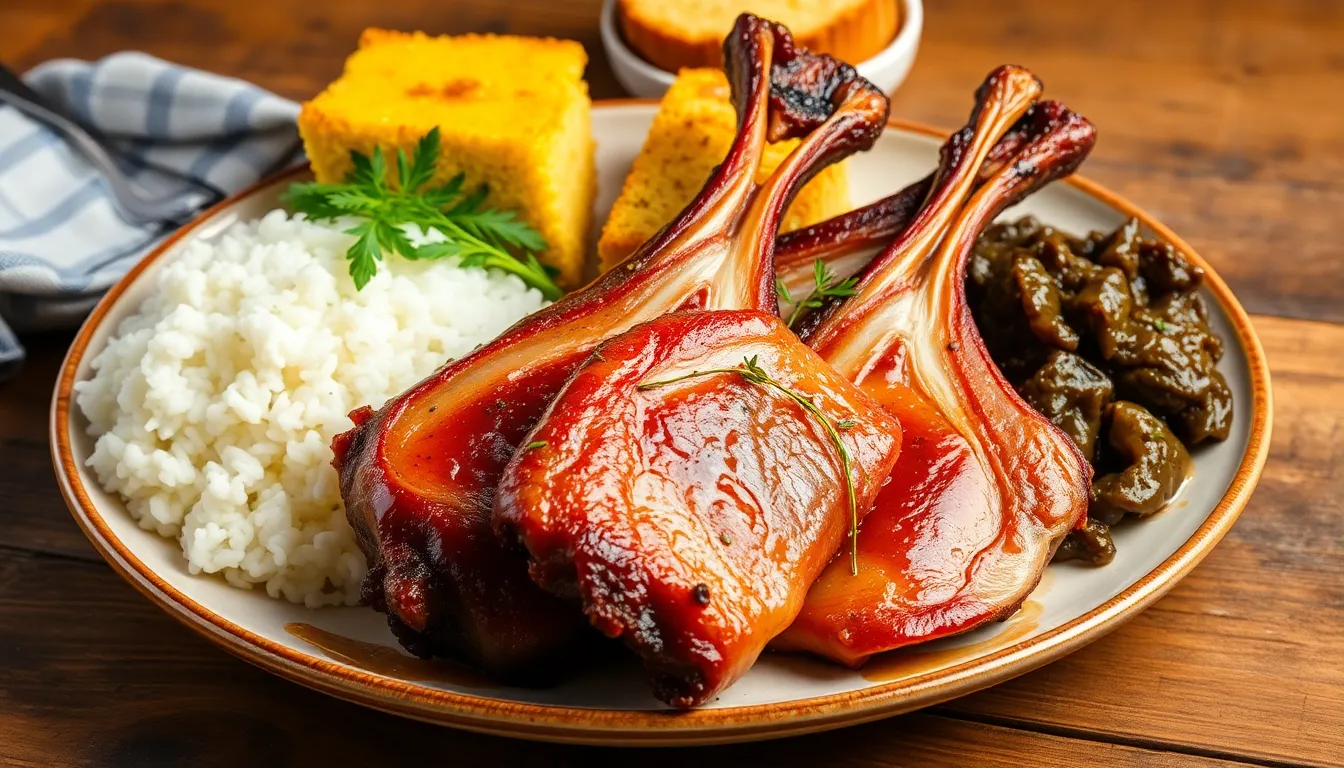
After smoking our turkey tails to perfection, we need to allow them proper time to rest before carving and serving. Rest the smoked turkey tails for 10 to 15 minutes once they reach that ideal internal temperature of 205°F to 210°F. This resting period allows the juices to redistribute throughout the meat, ensuring each bite delivers maximum flavor and moisture.
During the resting phase, we recommend loosely tenting the turkey tails with aluminum foil to retain heat without steaming the crispy skin we worked so hard to achieve. The internal temperature will continue to rise slightly during this time, helping break down any remaining connective tissue for ultimate tenderness.
We can serve our smoked turkey tails immediately after resting as a standalone dish, allowing the rich smoky flavors to shine through. The crispy mahogany skin paired with succulent dark meat creates an impressive presentation that showcases our barbecue skills. For a complete Southern-style meal, we pair the turkey tails with classic sides like fluffy white rice, buttery cornbread, or slow-cooked collard greens.
Transform leftover smoked turkey tails into a hearty smothered dish by creating a rich gravy base. Melt butter in a heavy pot, then sauté chopped onions, green bell peppers, and celery until softened. Build a golden roux by adding flour to the vegetable mixture, then slowly whisk in chicken broth to create a flavorful sauce. Add our rested turkey tails to the gravy and simmer until heated through.
Another popular serving method involves incorporating the smoked turkey tails directly into collard greens for added depth and smokiness. Boil the rested turkey tails until the meat becomes fork tender, then shred the meat and fold it into seasoned collard greens along with the cooking liquid for extra flavor.
Store any leftover smoked turkey tails in the refrigerator for up to four days, or freeze them for up to three months. Reheat gently in a low oven or on the stovetop with a splash of broth to maintain moisture and prevent the meat from drying out.
Storage and Reheating Instructions

Proper storage extends the life of our perfectly smoked turkey tails while maintaining their exceptional flavor and texture. We recommend transferring the cooled turkey tails to a tightly sealed container or Tupperware before placing them in the refrigerator. Our smoked turkey tails will keep well for several days when stored correctly using this method.
Refrigerator Storage
Place the turkey tails in an airtight container within two hours of cooking to prevent bacterial growth. Store them in the refrigerator where temperatures remain consistently below 40°F. The properly stored turkey tails maintain their quality for up to four days in refrigerated conditions.
Freezer Storage
For longer term storage we can freeze our smoked turkey tails for up to three months. Wrap each portion individually in aluminum foil or freezer safe bags to prevent freezer burn. Label containers with the date to track storage time effectively.
Reheating Methods
Several reheating techniques preserve the moisture and flavor we worked so hard to achieve during the smoking process. Each method offers different advantages depending on available time and equipment.
Oven Method: Wrap the turkey tails in aluminum foil and bake at 350°F until heated through. This gentle heating method prevents the meat from drying out while warming evenly.
Microwave Method: Place turkey tails in a microwave safe bowl and heat for 3 minutes. Flip the pieces halfway through the heating process to ensure uniform warming throughout.
Stovetop Method for Gravy: Remove any gravy from the turkey tails and place it in a skillet with a few tablespoons of water or broth. Simmer the mixture while whisking continuously until the gravy becomes warm and smooth again.
Storage Temperature Guidelines
| Storage Method | Temperature | Duration |
|---|---|---|
| Refrigerator | Below 40°F | 4 days |
| Freezer | 0°F or below | 3 months |
| Reheating | 165°F internal | Until heated through |
We find that gentle reheating methods work best to maintain the succulent texture and rich flavors that make our smoked turkey tails so special. Always verify that reheated turkey tails reach an internal temperature of 165°F before serving to ensure food safety.
Recipe Variations and Flavor Options
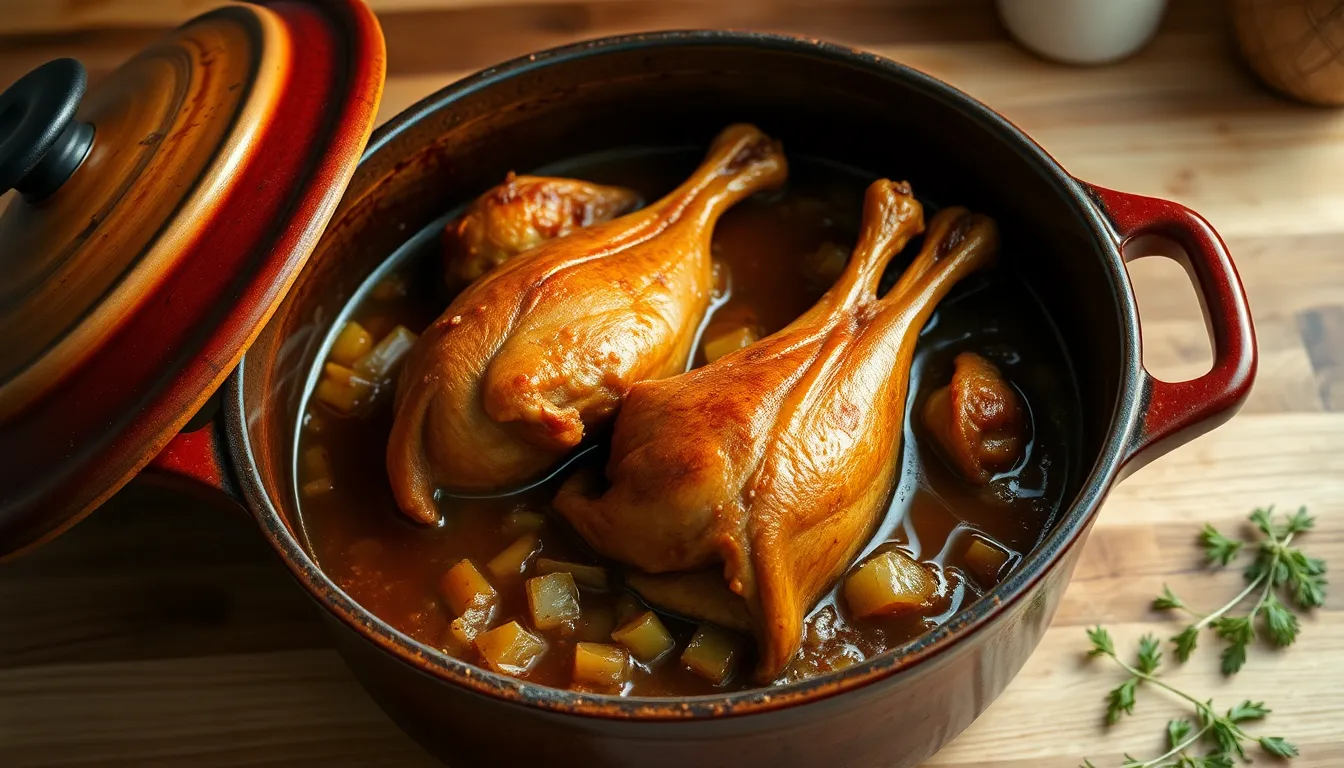
We love how versatile smoked turkey tails can be when you experiment with different cooking methods and flavor profiles. The classic smothered style remains our top recommendation for those seeking authentic Southern comfort food appeal. This variation involves creating a deeply flavored gravy using a traditional roux made from butter and flour, then adding chicken broth or stock to achieve the perfect consistency.
Our aromatic vegetable base typically includes chopped onions, celery, and bell peppers, which we call the “holy trinity” of Southern cooking. These vegetables infuse the gravy with layers of flavor while the turkey tails slowly braise in the rich sauce. We recommend cooking this variation in a Dutch oven at 350°F for approximately 2 to 2.5 hours, covered with aluminum foil to lock in moisture.
Seasoning Variations
We’ve discovered that customizing your seasoning blend can dramatically transform the final dish. Beyond our basic garlic powder, onion powder, and dried thyme combination, we encourage adding fresh parsley for brightness and color. Sweet bell peppers provide natural sweetness while delivering a subtle kick that balances the smoky richness of the turkey tails.
Some of our favorite regional variations include Cajun-inspired blends with paprika and cayenne pepper, or herb-forward combinations featuring rosemary and sage. We also enjoy experimenting with international flavors like jerk seasoning or Mediterranean herb blends to create unique fusion dishes.
Cooking Method Options
We find that your choice of cooking vessel significantly impacts the final result. Dutch ovens help concentrate moisture and flavors, creating an intensely savory environment for the turkey tails to braise. Roasting pans work well for larger batches and allow for better browning when you uncover the dish during the final 30 minutes to an hour of cooking.
Our slow cooker variation involves searing the seasoned turkey tails first, then transferring them to the slow cooker with vegetables and broth for 6 to 8 hours on low heat. This method produces incredibly tender meat that falls off the bone while developing deep, complex flavors.
Gravy Enhancement Techniques
We recommend enriching your gravy with butter to create a silky texture and enhanced tenderness in the final dish. Adding a splash of white wine or apple cider vinegar brightens the flavors and helps break down the connective tissues more effectively. For those who prefer thicker gravies, we suggest mixing a slurry of cornstarch and cold water before stirring it into the cooking liquid.
Our professional tip involves burning off any remaining hairs on the turkey tails with a lighter before cooking, which significantly improves both cleanliness and overall taste. This simple step ensures your finished dish has the cleanest possible flavor profile without any unwanted textures or odors.
Serving Suggestions and Side Dishes
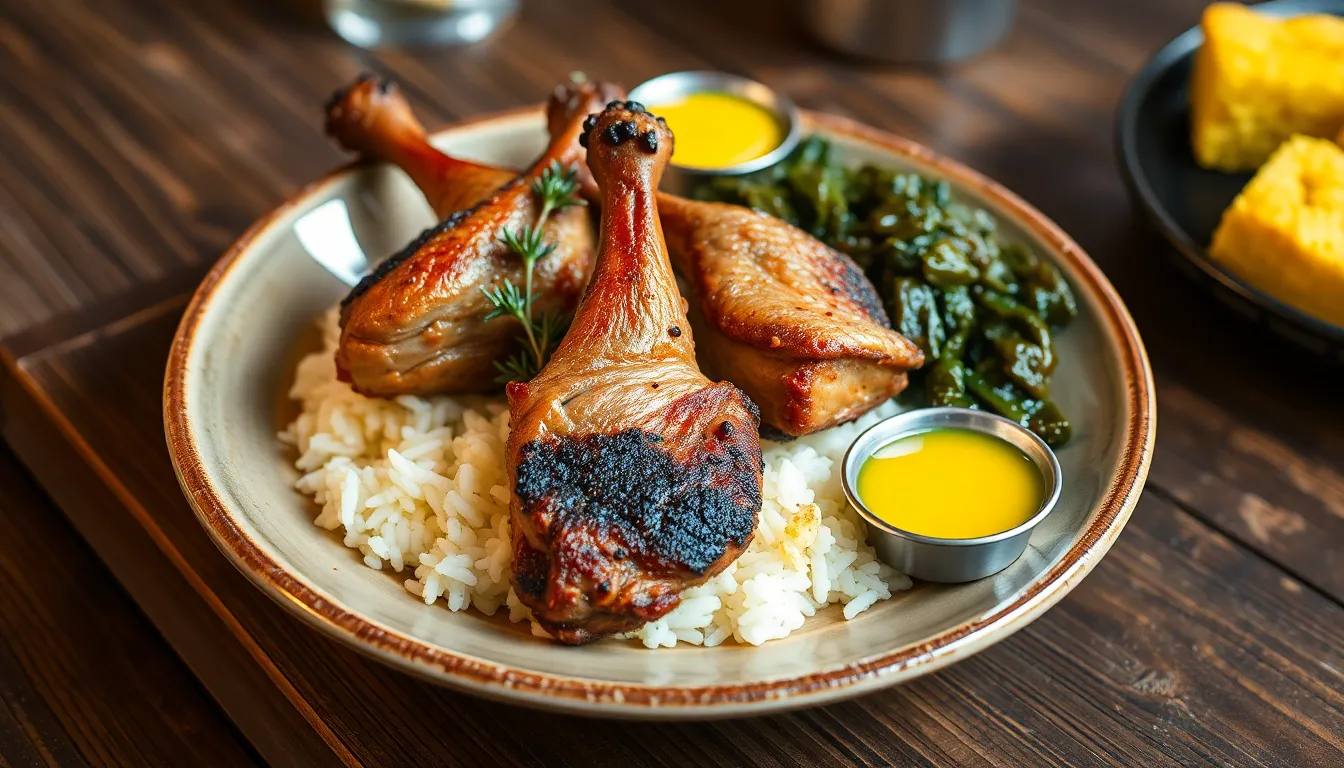
After smoking your turkey tails to perfection, we recommend serving them over a bed of steamed white rice to create a complete and satisfying meal. The fluffy rice acts as the perfect base for absorbing the rich flavors and natural juices from the smoked meat. A roux-based sauce made from butter, flour, onions, bell peppers, celery, chicken stock, and seasonings like garlic powder, onion powder, and thyme elevates this combination by adding depth and balancing the smoky richness.
Traditional Southern sides pair exceptionally well with smoked turkey tails, particularly collard greens that have been slow-cooked with the turkey tails themselves. We find that incorporating pieces of smoked turkey tails directly into the collard greens creates an incredibly flavorful side dish that complements the main course perfectly. The smoky meat infuses the greens with rich flavor while the greens provide a fresh contrast to the indulgent turkey tails.
For those who prefer a smothered preparation, we suggest creating a hearty dish by cooking chopped onions, green bell peppers, and celery with chicken broth to form a savory sauce. Combining the smoked turkey tails with this aromatic vegetable mixture and then baking or simmering until tender transforms the dish into a comfort food classic. This smothered style works beautifully when served alongside rice or crusty bread for soaking up the flavorful sauce.
Simple dipping sauces can enhance the eating experience without overwhelming the smoky flavors we worked so hard to develop. Yellow mustard serves as an excellent accompaniment, providing a sharp, tangy contrast that cuts through the richness of the turkey tails. We also recommend offering hot sauce on the side for those who enjoy additional heat and complexity.
Cornbread makes an ideal companion to smoked turkey tails, as its slightly sweet flavor and crumbly texture provide a pleasant contrast to the savory, smoky meat. We suggest serving warm cornbread with butter, allowing diners to create their own perfect bite combinations. Mac and cheese also works wonderfully as a side dish, with its creamy richness complementing the bold flavors of the smoked turkey tails.
| Cooking Time Overview | Duration |
|---|---|
| Total Recipe Time | 3-4 hours |
| Marinating Time | 1 hour |
| Smoking Time | 2.5 hours |
| Additional Glaze Time | 10 minutes |
Fresh vegetables like roasted Brussels sprouts, green beans, or a simple garden salad can help balance the meal by providing lighter flavors and textures. We recommend seasoning these vegetables simply with salt, pepper, and a touch of olive oil to avoid competing with the complex flavors of the smoked turkey tails. These lighter options ensure that the turkey tails remain the star of the meal while providing nutritional balance and variety.
Conclusion
We’ve shown you how to transform this underrated cut into a show-stopping barbecue centerpiece that’ll have your guests asking for seconds. The combination of proper preparation low-and-slow smoking and careful temperature monitoring creates turkey tails with crispy skin and incredibly tender meat.
The beauty of this recipe lies in its flexibility – whether you’re serving them simply with hot sauce or smothering them in rich gravy over rice the results are consistently delicious. With proper storage techniques you can even meal prep these flavorful tails for busy weeknights.
Don’t let another turkey tail go to waste. Fire up your smoker and discover why Southern pitmasters have kept this secret for generations. Your barbecue repertoire will never be the same.
Frequently Asked Questions
What are turkey tails and why should I smoke them?
Turkey tails come from the posterior end of the bird and contain dark meat with natural fats and connective tissue. They’re perfect for smoking because their high fat content makes them nearly impossible to overcook, resulting in crispy skin and incredibly juicy, flavorful meat that’s beloved in Southern cuisine.
How do I know when smoked turkey tails are done?
Turkey tails are done when they reach an internal temperature of 205°F to 210°F. Look for visual cues like golden-brown, crispy skin and meat that easily separates from the bone. The meat should be fork-tender and pass the tenderness test when pierced.
What temperature should I smoke turkey tails at?
Maintain your smoker temperature between 250°F and 275°F for optimal results. This low and slow cooking method allows the connective tissue and fat to break down properly, creating tender, juicy meat with crispy skin. Use indirect heat to prevent flare-ups.
How long does it take to smoke turkey tails?
Smoking turkey tails typically takes about 2.5 hours at 250-275°F. However, focus on internal temperature and tenderness rather than strict timing. Cooking time may vary based on size, smoker efficiency, and weather conditions.
What wood should I use for smoking turkey tails?
Use mild, slightly sweet woods like apple, cherry, hickory, or pecan for smoking turkey tails. These varieties complement the turkey’s natural flavor without overpowering it. Avoid strong woods that might mask the meat’s delicious taste.
How should I prepare turkey tails before smoking?
Clean and trim the turkey tails, removing any remaining feathers. Apply a dry rub with garlic powder, onion powder, and turkey seasoning. For enhanced flavor, marinate them in a mixture of white vinegar, water, garlic, and rub for about an hour.
What sides pair well with smoked turkey tails?
Serve smoked turkey tails over steamed white rice with a roux-based sauce. Traditional Southern sides like collard greens, cornbread, and mac and cheese complement them perfectly. You can also create a smothered preparation with aromatic vegetables.
How do I store leftover smoked turkey tails?
Store cooled turkey tails in an airtight container in the refrigerator for up to four days. For longer storage, wrap individually and freeze for up to three months. Reheat gently in the oven, microwave, or stovetop until internal temperature reaches 165°F.
Can I make a glaze for smoked turkey tails?
Yes! Create an optional glaze using honey, soy sauce, Dijon mustard, minced garlic, and a dash of hot sauce. Apply the glaze during the final stages of smoking using a silicone basting brush for even coverage and enhanced flavor.
Where can I buy turkey tails?
Most butchers can source turkey tails upon request, even if they don’t regularly stock them. Look for fresh turkey tails with pinkish-red meat, creamy white fat streaks, and firm texture. Frozen options work well if completely thawed before preparation.

